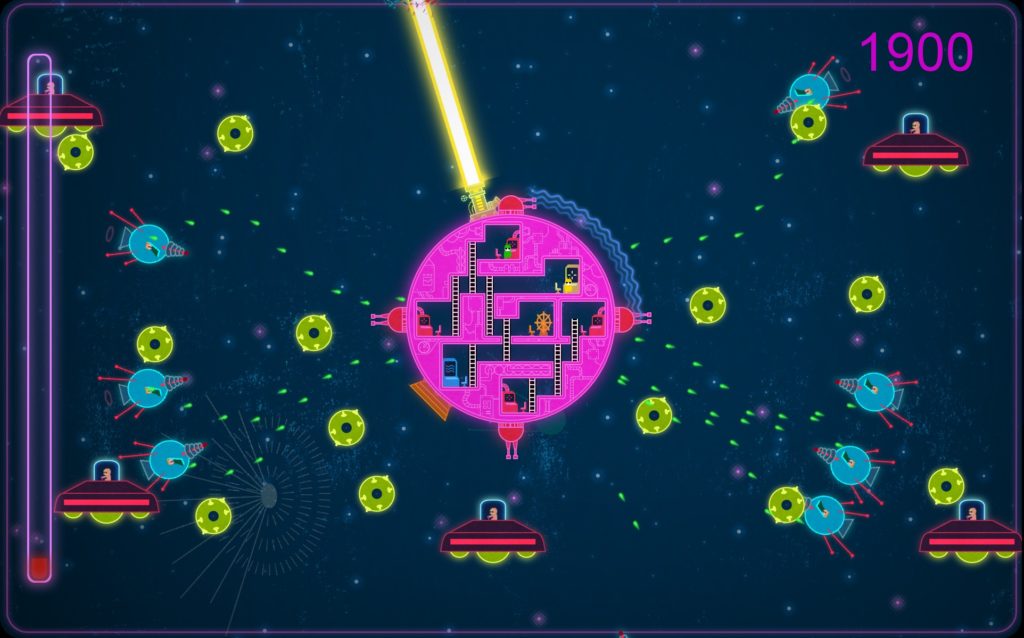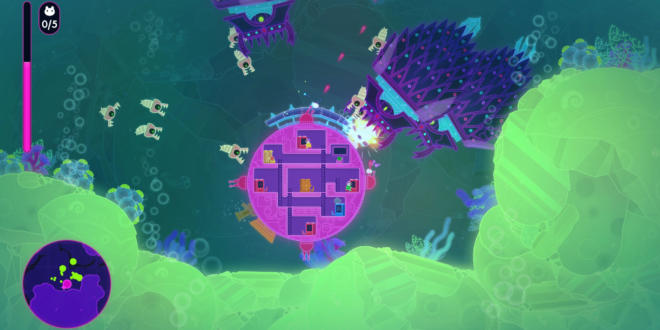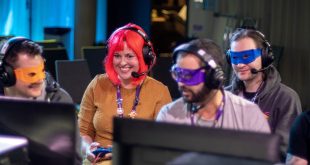
Lovers in a Dangerous Spacetime celebrates its fifth anniversary today. The co-op space shooter has seen consistent appeal other the years, as detailed in an article today on its sales figures over those years. Here we look back at how the game came into being…
Lovers in a Dangerous Spacetime is immediately recognisable on many levels. For starters, the name is pretty unusual, somewhat lyrical (we’ll get into that later) but it still does a fair job of describing this game of space combat and survival.
Then there’s the astoundingly lurid colour pallette and cutesy characters. Which are somewhat at odds with its, at times, pretty demanding nature. And finally there’s the game’s immediacy, where just a glance at a screenshot makes it instantly apparent what you’re supposed to do in it, even though it’s pretty original in its approach to what is an increasingly rare gaming segment: couch co-op.
JAMMING AROUND THE GLOBE
Talking to MCV, Matt Hammill, designer and animator on Lovers in a Dangerous Spacetime explains how the idea began at the local Global Game Jam 2012 event in Toronto:
“A lot of us grew up playing couch co-op games with our siblings, and were nostalgic for being in the same room as the people you’re playing with. There were other developers in Toronto who’d done some really fun local co-op games. A Friendship in Four Colours and Cephalopods Co-op Cottage Defence. Hammill was jamming with illustrator Jamie Tucker and programmer Adam Winkels, with music and sound provided by Ryan Henwood. “Eventually we hit on this idea of flying a spaceship together, like that scene in Star Wars where Han Solo and Luke Skywalker are shooting the Tie Fighters and shouting back and forth to each other.
It’s an iconic scene of course, but most examples of putting multiple players into a single spaceship were pretty serious in their approach. Hammill namechecks Artemis: Spaceship Bridge Simulator, a cult hit that allowed multiple players to fly a Star-Trek style ship into combat using numerous local networked PCs. The team’s idea was far, far simpler. “It started out as a sketch, I had an overhead view of a spaceship, and you could see the wings and there were some rooms inside it, and it was this overhead game and you controlled these little guys inside.”

Hammill’s image reminds us of the Millenium Falcon, which was somewhat unusually homelike in its scale, a series of small rooms, rather than Star Trek’s battleship-scaled Enterprise, or the usual tiny one-man fighters.
“It almost looked like FTL, whose kickstarter came out a little bit later,” Hammill recalls. “But Jamie said what if we flip it on its side? Make it a little mini platformer inside the ship. And that seemed a little bit more ridiculous and a little bit more actiony.” Maybe that was the moment that Lovers really came to life.
That sense of jumping and climbing around the ship does provide a sense of impetus. The characters are more clearly-defined side on than they would have been from above, and the world the ship inhabits also gained a lot of character from this perspective choice.
“That decision led to a lot of other decisions, like the spaceship suddenly had to be round, or it worked well to have a round spaceship because then you can have the engine and shields move around the ship pretty simply, with the gunpods on each side.” The simple design of the ship remains the key brilliance of Lovers, with players easily able to switch from driving, to shields, to the four main guns, the special weapon and the navigator’s map as up to four players dynamically fill the roles needed at that moment.
TORONTO UNITED
“We had a super simple game jam version that we did in Gamemaker. It was just a single screen with the ship in the middle, you could fly the ship around the screen, enemies will appear from the edges and you would shoot them until you died. It was like a take on Asteroids. That initial version from the game jam is remarkably close to the (far more polished) final version in terms of the core design elements and styling. But despite its obvious appeal the team didn’t launch straight into it as an ongoing project.
“It didn’t start out as a plan to make a commercial game, it started out as me wanting to learn Unity in my spare time, so I started remaking the game in Unity. Then the others from the game jam joined up again and we all started working on it together.“We were doing it part time, starting late 2012 and early 2013. It was probably a year and-a-half, we were all doing part-time work and part time on this project. Three days a week at work and then we were trying to put two to two and-a-half days into the game.”
LOVING IT UP
That’s a pretty hard grind, as anyone who’s had to work to fund an ongoing indie project will know. But despite all that, the game itself is an absolute riot of exuberance – neon colours, cutesy characters, chirpy sound effects and Henwood’s playful and varied electronica.
Speaking on the full-on colour pallette, Hammill tells us: “That was from really early on, since we had borrowed so heavily for the theme from Star Wars and Star Trek, I really wanted to not also borrow the generic sci-fi aesthetic too.” He admits that a space shooter, even a somewhat inventive one, is a “cliche”, so the team thought “let’s try and push it in a different direction visually.” We wonder if it was also an attempt to court a more casual audience, but apparently that wasn’t a key factor:
“We only started thinking along those lines a lot later, maybe this will work better for families, parents and kids playing it together. At first it was just for fun, it was just because I liked Sailor Moon and other anime, and we thought it would be so cool to do something really fun and bonkers and candyland.
LOVABLE ROGUE
That’s all backed up by the team’s desire for the game to be challenging, despite its cutesy aesthetic trappings. Something demanding for gamers like them, not a family-friendly experience at all – which went hand-in-hand with their passion for procedural-generation.
“When we stared it we thought: ‘all these roguelikes are really cool right now, the way you can play it forever’. And it took us a long time to move away from that,” Hammill explains. “It seems obvious now, but at the time, when we were thinking about the roguelike thing, we were trying to make it a really hard game, like this hardcore, randomly generated, punishing game, which in hindsight it seems totally obvious to not to go down that route, but at the time it’s what we were playing
and what we were into.”
And, to its benefit, elements of that roguelike approach are still present in the final game.

“Even in the final version the levels are made of authored bits, but if you replay a level things will be in different places, so there’s a little bit of that left. Originally we wanted to do a roguelike model because if you’re playing with two people we didn’t want to have one of them remember the level layout, know where everything was, and just be tell the person what to do.” It’s an excellent point and one that can stymie fixed designs such as Ghost Town Games’ Overcooked when you have one very experienced player in the party. It’s a phenomenon that co-op board games call ‘quarterbacking’ and is a key criticism of many designs such as Overcooked’s
That desire to keep the game challenging also restricted the number of players at first, Hammill explains: ”That’s why we originally launched it with just two players, because we found that early on when we were testing it with four players, it was really difficult to balance it and keep it challenging, which is what we were really focused on. “And then after release, a few months later, we did the four player update. We tried to make it a little bit more challenging, but by then we were a lot more like ‘it’s just a fun game it doesn’t need to be this punishing, gruelling experience.’”
“If we were to go back and do it again I’d focus even more on making it more accessible for families, I think that seems to be where its found its niche, it’s fun to play with kids and everyone can have different roles.”
BOSS IS APPROACHING!
One feature we really love about Lovers is its power-up system, allowing players to mix-and-match a variety of crystals onto each station, with different combinations providing numerous, varied effects.
The inspiration for the system came from a Mega Drive classic, Hammill tells us: “It’s a total rip-off of Gunstar Heroes.” Which is head-slappingly obvious once mentioned, but we never noticed it before, despite it being one of our favourite games ever, “it’s something me and my brother used to talk about growing up, it seemed too irresistible, we couldn’t not rip it off! So that was something that we always wanted to do, but is it too many weapons, too difficult? We eventually decided to go with making a spreadsheet and filling in the blanks of what these combos could be, and it was just too much fun to think about and not make it.”
“If we were to go back and do it again I’d focus even more on making it more accessible for families”
We’re particularly keen on the upgrades to the engine and shield systems which turn them into ad-hoc weapons in their own rights. But even the gun upgrades can radically change the way you have to go about killing your harassers. “Because your interactions are pretty limited when you’re on one station, you can only do the direction and hit the button, so we tried to think of things to at least change the rhythm of the different stations.”
And it’s a huge success, bringing not only different play styles, but often heated debate as to where that next crystal should be placed, as they’re locked in place until at least the end of the level.
FUNDING AND LAUNCH
By this point Lovers itself was nearing the end of development, but it needed some help to get it over the line, Hammill explains.“Behemoth [the developer behind 2D beat ‘em up Castle Crashers] had a funding arm where they give bridge financing to help indie teams get their games across the finish line. They reached out to us, we didn’t even know about it, but it enabled us to go full time. So there was a year of full-time work towards the end of the project.”
That brought the game to launch in September 2015 on PC, Linux, OS X and Xbox One , with a PS4 version following quickly in February 2016. Though it was very well-received critically, it wasn’t the launch that indie dreams are made of. “At launch it was very modest, we launched it and were like ‘OK, at least we tried’. We launched it on PC and Xbox One at the time, and on both of those platforms the launch was not exactly awesome,” Hammill admits.
Thankfully, unlike so many great games, Lovers made up ground over time, and all thanks to it being a bit different: “There’s just not that many local co-op games, I still see it on Twitter where people say ‘I’ve just played Overcooked’ and ask what other local co-op games are there to play, and people mention our game in reply. So since then we’ve been extremely lucky and it’s done better and better over time, I think that’s extremely rare these days for indie games,” and we’d certainly agree with that sentiment.
“We’ve been extremely lucky and it’s done better and better over time”
“So it’s done so much better than its launch, and since we launched on Switch too [October 2017], that’s been really good. I think the platform dovetails with the kind of players who would be into it, like families and local co-op.” Hitting the Switch market around six months after the platform launched, before it was deluged with titles, was “fortuitous timing” Hammill says, but just looks like canny business sense to us.
SING-A-LONG A SHOOTER
Despite its long tail success, Lovers developer Asteroid Base is currently in statis, something that makes us a little sad if we’re honest.
“We tossed around a few ideas, but everyone was in a different place in their lives. Just the demands of doing that whole indie studio thing again, but just in terms of time commitment and financial risk, the whole team wasn’t exactly all in the same place,” Hammill explains, adding cheerily: “we’re all still friends. Right now we’re all on different projects, with different partners… Personally, I’m working on a new project with Cellar Door Games, who did Rogue Legacy. They’re here in Toronto, so I’m working with them on an unannounced project right now,” Hammill concludes, and we wonder if he’s finally getting to make that rougelike after all.
Oh and we almost forgot about that unusual name, which apparently is all very Canadian, Hammill tells us: “The name came from that initial game jam. We were singing the famous-in-Canada song: Lovers in a Dangerous Time by Bruce Cockburn, covered by another famous-in-Canada group Barenaked Ladies… and it was late at night… and, well, it stuck.”
Its creators may no longer be singing together over their keyboards as they develop games, but Lovers in a Dangerous Spacetime is continuing to bring many, many players together for a bit of classic couch co-op action.
So in the spirit of Asteroid Base, just maybe we’ll try a Canadian-style sing-a-long next time we play.

 MCV/DEVELOP News, events, research and jobs from the games industry
MCV/DEVELOP News, events, research and jobs from the games industry




